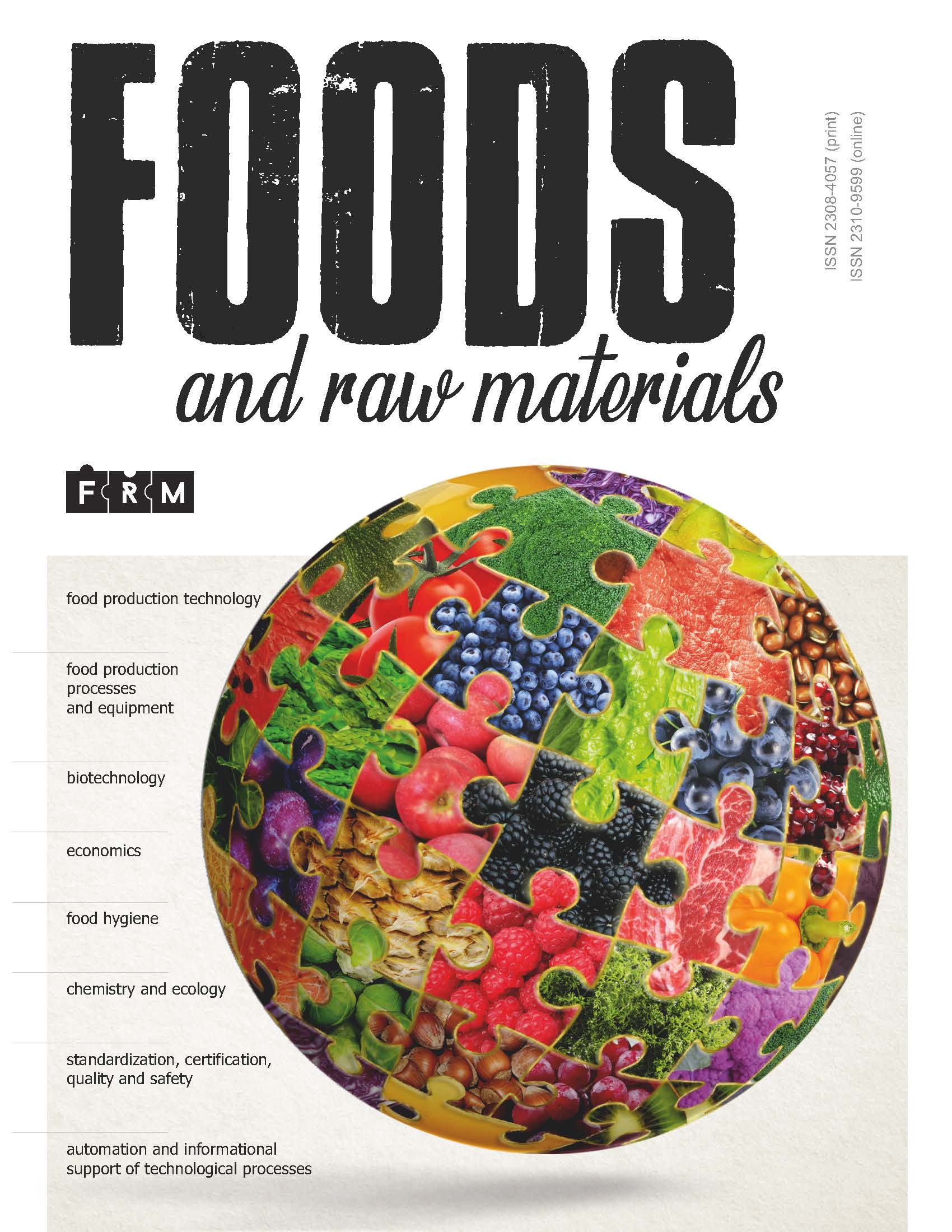Identification has similarities and differences with other kinds of assessment activity: quality assessment, control management and certification. The final result of identification is verification of compliance or detection of falsification. Common features are tests for definition of actual values. This paper studies the design of universal primers for type identification of fruit raw material (strawberry, gooseberry, cherry, raspberry, banana, wild rose, kiwi). To further verify the specificity of primers, sequencing of fragments is produced, which are read by each from the primer pairs. For this purpose, 8 polymerase chain reactions (PCR-reactions) are initiated, one from each primer pair corresponding to one type of raw material. A single alignment matrix for each of the studied objects is created as a result. Re-verification of each matrix is conducted for the presence of read errors or other disputed single- nucleotide substitutions. It is stated that the alignment matrices of the nucleotide sequences of raspberry, strawberry (fragaria viridis), gooseberry, wild rose, cherry, banana and kiwi are aligned on all sides and the protruding "bases" do not disturb the future work of programmes for the primers design. Universal non-intersecting primers are chosen to identify the fruit raw material under studying. As a result of the use of various software packages and of the database GenBank NCBI, we managed to find a suitable DNA zone for each of the tested samples of fruit raw material at the level of generic differentiation for further development on its basis of the universal primers. It is zone 18S rDNA. All the found sequences have both the conservative part for planting a pair of primers, and the variable one for reliable identification of species or for phylogenetic analysis. As part of the study, all samples of fruit raw material have been identified
Fruit raw material, identification, PCR, matrix, primers
1. Avilova I.A. and Khlystov D.V. The possibility of using the method of IR spectroscopy for the analysis of raw materials and foods of plant origin. Izvestiya Jugo-Zapadnogo gosudarstvennogo universiteta. Seriya Fizika i khimiya [News of Southwest State University. Physics and Chemistry], 2014, no. 1, pp. 34-37. (In Russian).
2. Urbanovich O.Yu., et al. Analiz genov ustojchivosti kak molekulyarnye markery dlya identifikatsii sortov rastenij [Analysis of stability of genes as molecular markers for identification of plant varieties]. Sbornik nauchnykh trudov «Molekulyarnaya i prikladnaya genetika» [Collection of scientific works “Molecular and applied genetics”], 2006, vol. 3, pp. 3-142.
3. Golubtsova Yu.V. Selection of seeding molecules in the process of pcr-test-system creation for identification of vegetable raw materials in foodstuffs. The Bulletin of KrasGAU, 2014, no. 10, pp. 194-200. (In Russian).
4. Guchetl S.Z., Cheljustnikova T.A., and Antonova T.S. The optimization of DNA extraction of broomrape (Orobanche cumana Wallr.) and the identification of polymorphic RAPD- and SSR-loci for genotyping of parasite. Refereed journal "”Oil crops. Scientific and Technical Bulletin VNIIMK”, 2013, iss. 155-156, pp. 17-23.
5. Davidovich E.A. Identifikatsiya podlinnosti i urovnya kachestva kon'jachnoj produktsii [identification of originality and quality level of cognac products]. Pishhevaya i pererabatyvajushhaya promyshlennost'. Referativnyj zhurnal [Food and processing industry. Abstract journal], 2006, no. 4. p. 1012. (In Russian).
6. Kolesnov A.Y., Filatova I.A., Zadorozhnaya D.G., Filippova R.L., and Volodina E.M. Practical aspects of identification juice and juice products: pomegranate juice and juice products. Beer and beverages, 2010, no. 4, pp. 41-45. (In Russian).
7. Ostroumov L.A., Prosekova O.E., and Prosekov A.Yu. Osobennosti proizvodstva vzbitykh desertov na osnove belkovo-uglevodnogo i rastitel'nogo syr'ya [Specific features of production of whipped desserts based on proteincarbohydrate and plant raw material]. News institutes of higher Education. Food technology, 2003, no. 1, pp. 28-29. (In Russian).
8. Prosekov A.Yu. Teoreticheskoe obosnovanie i tekhnologicheskie printsipy formirovaniya molochnykh penoobraznykh dispersnykh system [Theoretical justification and technological principles of formation of milk foam dispersed systems. Dr. tech. sci. dis. abst.]. Dr. eng. sci. thesis. Kemerovo, 2004. 42 p.
9. Prosekov A.Yu., Mudrikova O.V., Bulavina A.V., and Arkhipov A.N. The methods of the DNA technologies for the vegetable raw materials identification in milk products. Dairy industry, 2011, no. 12, pp. 62-63. (In Russian).
10. Prosekov A.Yu., Golubtsova Yu.V., and Shevyakova K.A. Influence of technological raw food treatment on the effectiveness of species identification. Food processing industry, 2014, no. 6, pp. 8-10. (In Russian).
11. Rykov R.S. Razvitie metodov identifikatsii i kontrolya bezopasnosti napitkov [Development of methods of identification and control of drinks safety]. Cand. chem. sci. diss. Moscow, 2005. 137 p.
12. Prosekov A.Yu. Theori and practice of prion protein analysis in food products. Foods and Raw materials, 2014, vol. 2, no. 2, pp. 106-120. DOI:https://doi.org/10.12737/5467.
13. Dyshlyuk L., Babich O., Belova D., and Prosekov A. Comparative analysis of physical and chemical properties of biodegradable edible films of various compositions. Journal of Food Process Engineering, 2017, vol. 40, no. 1, Article number e12331. DOI:https://doi.org/10.1111/jfpe.12331.
14. Novoselova M.V. and Prosekov A.Yu. Technological options for the production of Lactoferrin. Food and Raw Materials, 2016, vol. 4, no. 1, pp. 90-101. DOI:https://doi.org/10.21179/2308-4057-2016-1-90-101.
15. Astakhova L., Babich O., Prosekov A., et al. Short chain fatty acids (SCFA) reprogram gene expression in human malignant epithelial and lymphoid cells. PLoS ONE, 2016, vol. 11, no. 7, pp. e0154102. DOI:https://doi.org/10.1371/journal.pone.0154102
16. Prosekov A.Yu., Mudrikova O.V., Bulavina A.V., and Arhipov A.N. The methods of the DNA technologies for the vegetable raw materials identification in milk products. Dairy industry, 2011, no. 12, pp. 62-63. (In Russian).
17. Bespomestnykh K.V., Babich O.O., Korotkaya E.V., and Prosekov A.Yu. Design of genus-specific and speciesspecific primers for indication and identification of Lactobacillus bulgaricus. Food Processing: Techniques and Technology, 2010, vol. 16, no. 1, pp. 64-68. (In Russian).










